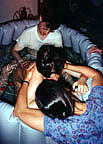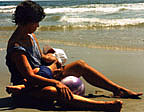BENEFITS
AND RISKS
OF
WATER LABOR/BIRTH
Advantages for Mother
 |
• Safer, more effective and economical than an epidural
• Waterbirth coined as an "aquadural" or "wetepidural"
• Pain significantly reduced by blocking nerve impulses of pain to the brain known as the Gate Theory of Pain
• Study in Canada; 100% women who birthed in water use no pain medication
• Less use of analgesics and anesthesia
• Fewer birth canal injuries, vagina, perineum and vulva
• Reduction of labor length
• Reduction of episiotomies and painful stitching, water relaxes the pelvic floor muscles
• Decreases maternal hypertension, high blood pressure
• Increases maternal connection over labor and birth environment
• Increases maternal autonomy
• Greater mobility for maternal positioning during labor and birth
• Conservation of maternal energy
• Better focus and concentration in water
• Less blood loss during the birth
• Deeper relaxation resulting in hormones kicking in
• Less pressure on the abdomen because of the buoyancy promoting more efficient contractions, better blood circulation, more oxygen to baby and mother, equal pressure on all parts of the woman's body.
• Helps to relieve anxiety and promote focusing inward, as labor becomes more intense
• Moist air assist better breathing for mother specifically if asthmatic
 |
• Facilitates a dysfunctional labor by stimulating dilation of cervix
• Can speed up normal labors, sometimes resulting in less than a two to four-hour birth in total
• Many experience more rapid second stage with baby emerging within a few pushes, also known as the 'fetus ejection reflex' (term by Dr. Michel Odent)
• Effective tool to easing the woman into and through transition to pushing
• More trust in the process by feeling of weightlessness allows woman to concentrate on letting her body do what it was designed to do
• Water labor or birth can result in lower adrenaline, (fight or flight response) levels
• Warm water stops false labor contractions
• Assists pushing to an easier place
• Reaching another state of consciousness where fears and resistances are released or dissolved
• Sound of water running or the jets on belly or back create more endorphin secretion
• Clean up is easier with less mess
• Empowering experience for mother without drugs, no surgical procedure, moving in any position, developing inner strength and power enriching her life forever
• Family relationships empowered with mother in less pain; father takes more active role in birth experience resulting in deeper bonding and a more enhanced relationship the rest of their lives
• Parent-child interactions are enhanced by a positive experience in her body/mind/spirit, less painful, gentle approach in bringing child to the planet
• Reduction of Cesareans
• Mother or father can more readily catch her baby
• Bacteria is dissipated in water reducing infection to mother
Advantages for Baby
 |
• Easier more gentle transition from one womb of water to an external womb of water, weightless, warm, wet and soft
• Decreased trauma at birth
• More blood to baby due to better blood circulation in mother
• Baby doesn't receive the invasive stimuli to induce breathing, which results in less crying, babies after birth resulting in a calmer, more alert state
• More safe than unsafe alternative in childbirth
• Bacteria is dissipated in the water reducing infection to baby
• Cord cutting after birth is delayed until it stops pulsating
• Less problems with breastfeeding after birth
• Less trauma to mother means less trauma to baby
• Babies brought into a world with less violence have a greater potential to integrate into the world with less violence
Contraindications for a Waterbirth
 |
•Fearful Attendant - A fearful attendant translates into a fearful mother and a stalled labor. Make sure that someone you trust and respect attends your birth as a medical and non-medical caregiver.
•HIV or Hepatitis - This is at the discretion of the attending medical caregiver. Generally there is no reason to restrict an HIV positive mother from laboring or giving birth in water. Evidence shows that HIV virus is susceptible to the warm water and cannot live in that environment . Proper cleaning of all equipment after the birth needs to be carried out.
•Herpes - Because herpes is highly transferable, it is advisable not to utilize water as a labor or birth tool. However, you may discuss this with your medical caregiver.
•Inflexibility - If you are determined to have a waterbirth no matter what, you might want to rethink waterbirth. Every birth is different, so you need to remain flexible and realize that your carefully constructed birth plan may not become a reality in its entirety.
•Malpresentation - Position of the baby upon descent down birth canal (i.e., breech). Still, some medical caregivers will support water immersion and/or waterbirth for breech presentation (Franklin [bottom first] or Footling [feet first] breech). A prominent Ostend, Belgium Obstetrition uses a frank breech position as an indication for a waterbirth.
•Medical Conditions - Certain medical or obstetrical diagnosed by a physician. Such conditions may include, but are not limited to, excessive bleeding, maternal infection, and multiple births.
•Mutiples - Twins have become more possible to birth in water, particularly in Ostend, Belgium at the Aquatic Maternity Centre in the Henry Serruys Hospital. In seventeen years, over 2,500 aquatic births with no infections or deaths from drowning have transpired at this Hospital. Dr. Ponette, chief OB-GYN assist women with breech, twins presentations. If you were working with a facility or obstetrition with limited experience in the world of water, it would best to change your plans or travel to a facility that will support your choices.
 •Premature
Labor Threatened or actual. If a baby is pre-term, indicating
two weeks prior to scheduled due date, waterbirth is not recommended.
With advances for waterproof fetal monitoring, there are fewer
reasons to require a woman to leave the pool. Doctors have experienced
great results with babies born from thirty-six weeks gestation.
A few cases of waterbirth for thirty-three, thirty-four and thirty-five
week old babies have been reported.
•Premature
Labor Threatened or actual. If a baby is pre-term, indicating
two weeks prior to scheduled due date, waterbirth is not recommended.
With advances for waterproof fetal monitoring, there are fewer
reasons to require a woman to leave the pool. Doctors have experienced
great results with babies born from thirty-six weeks gestation.
A few cases of waterbirth for thirty-three, thirty-four and thirty-five
week old babies have been reported.
•Severe Meconium - Meconium is another word for feces. If there is moderate to severe meconium in the amniotic fluid, waterbirth is not recommended. Mild to moderate meconium is fairly normal. Since meconium usually floats to the surface in a tub it can (and should) be removed from the tub promptly. It has been seen that meconium washes off the face of the baby and even comes out of the nose and mouth while the baby is still under water. If the water is stained and birth is imminent, the woman can lift her pelvis out of the water to birth the infant.
•Shoulder Dystocia - This is usually considered an obstetric or midwifery emergency by most. Protocols require the mother who is anticipating a large baby to leave the water. Now there are some that find it is easier to assist a shoulder dystocia in the water. It is believed that tight shoulders happen more often because of mom or caregiver trying to push before the baby fully rotates. Better to wait a few contractions and allow baby to rotate. Because position changes in water are so much easier than dry land, a quick switch to hands and knees or even standing up with one foot on the edge of the pool helps to maneuver baby out. The water can be draining from the pool at the same time.
•Toxemia - Abnormal swelling, diet related.
•Water Temperature - Too warm -- Mother's body temperature rises, energy is sapped. Suggestion: Have woman hold on to ice cubes, suck on a cold washcloth,or drink cold water. Too cold -- Mother's body temperature will drop the sweating mechanism for heat loss doesn't work in water. Too early -- If the woman gets into the tub too early (during the first stage of labor), labor may stall or slow down.
